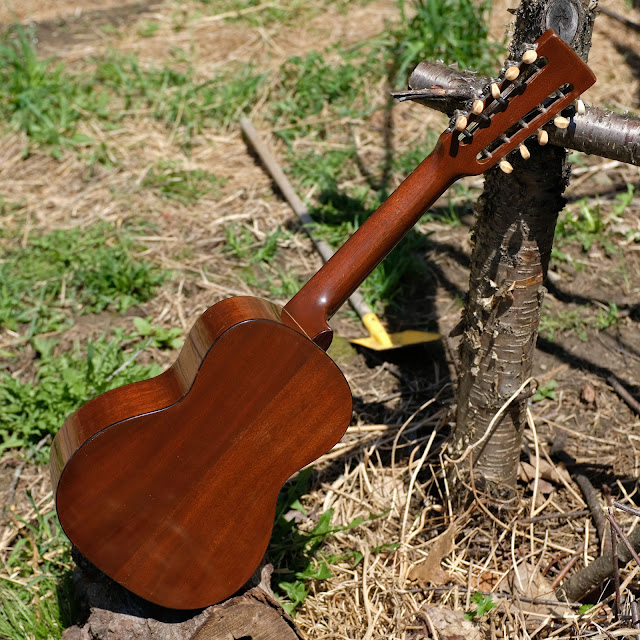1949 Martin T-18 Tiple
This, folks, is a proper tiple -- a tiple in the US being a ukulele-tuned, tenor-uke-sized, 10-steel-string, mini-12-string-sounding box of dubious South American-via-East Coast origins. It's x-braced and sturdy, built to a quality spec, and its tone is smooth as silk and still manages to be jangly and forward. I like it! It's also a one-owner instrument and was sold to my consignor by the original owner's wife. He played it like mad per the pick/strumming wear on the upper bout. He treated it right, however, and it's very clean for its age aside from that pickwear.
My work included a fret level/dress, slight widening of the saddle slot and installation of a compensated bone saddle (these originally have fret-saddles that don't intonate well at all), cleaning, and a good setup. One of the tuner buttons crumbled while I was tuning-up (it must've had a small split in it as the others are perfectly good), so I replaced that one with a vintage button that I trimmed-down to look (mostly) the part. It's ready to go and plays fast and easy.
Specs are: 17" scale, 1 1/2" nut width, 1 5/16" string spacing at the nut, 1 13/16" spacing at the bridge, 9" lower bout width, 6 5/8" upper bout, and 3 5/8" side depth at the endblock. The neck has a flat fretboard and medium-sized C profile to its rear. Action is spot-on at 1/16" at the 12th fret and I've strung it with my usual tiple set for GCEA tuning running: 10/22w, 16/36w/16, 13/30w/13, 9/9. The neck is straight and its 109809 serial number points to '49.
The top is solid spruce while the back and sides are solid mahogany. The neck is mahogany to and the fretboard and bridge are both Brazilian rosewood -- as is the headstock veneer. The instrument is entirely original except for the new saddle and one tuner button. It also has old-job, touched-up finish on the top wherever there was pickwear on the upper-bout.
There's the faintest whisper of a hairline crack on the lower-bout, top, treble side right next to the binding -- but it doesn't go through and is over the kerfing, anyway, and so is a non-issue. That's the only "crack" I could find.
The trim is refined and elegant -- as you'd expect.
The compensation at the bridge isn't 100% perfect, but it's pretty good. I couldn't move the saddle the tiny amount it should be forward (about 1/64" to 1/32") as the sidewall for the saddle slot was just a little too thin to do so. A player that has an extremely light touch might find that the high A is just a tiny bit flat at the 12th fret, but a normal-touch player won't notice at all (because an average player -- like myself -- will press down enough to sharp it anyway).
The tortoise binding looks great!
I've shot this pic in glare so you can see the washboard pickwear effect on the upper bout. There's an old layer of touch-up finish in these previously-exposed areas.
The marbled tuner buttons look awesome.
Oops! That endpin is a replacement from my parts-bins, too.
Here you can see that x-bracing.
It comes with the basically-trashed original chip case.
There's a stack of ephemera with it, too, including a letter from the original owner's wife to/from Martin in the '80s, a bunch of old Black Diamond string packets, and popular song lyrics from the '40s-through-'50s.

























Comments
Every other manufacturer that I've played had them ladder-braced.
is this one still for sale ?
THanks, Ray